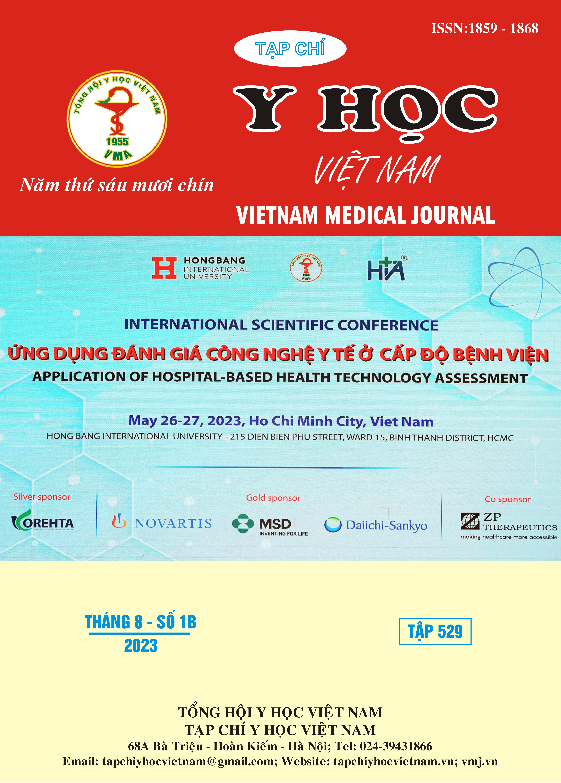TÌNH TRẠNG DINH DƯỠNG CỦA BỆNH NHÂN PHẪU THUẬT VÙNG BỤNG CÓ CHUẨN BỊ TẠI BỆNH VIỆN ĐA KHOA TRUNG ƯƠNG CẦN THƠ
Nội dung chính của bài viết
Tóm tắt
Đặt vấn đề: Tình trạng dinh dưỡng là một trong những yếu tố quyết định sự thành công của phẫu thuật và việc sàng lọc dinh dưỡng trước phẫu thuật giúp phát hiện bệnh nhân có nguy cơ về dinh dưỡng trước phẫu thuật. Mục tiêu: Đánh giá tình trạng dinh dưỡng và tìm hiểu một số yếu tố liên quan trên bệnh nhân phẫu thuật ổ bụng có chuẩn bị tại bệnh viện Đa khoa Trung Ương Cần Thơ. Phương pháp: Nghiên cứu mô tả cắt ngang, trên 92 bệnh nhân phẫu thuật ổ bụng có chuẩn bị, thời gian nằm viện ≥ 2 ngày, từ tháng 08/2019 đến 12/2019 tại bệnh viện ĐKTW Cần Thơ. Tình trạng dinh dưỡng được đánh giá bằng chỉ số khối cơ thể (BMI), SGA và các chỉ số hóa sinh như Albumin và Pre-albumin. Kết quả: theo phân loại của SGA có 63% bệnh nhân suy dinh dưỡng; 22,5% bệnh nhân suy dinh dưỡng phân loại theo BMI. Nghiên cứu ghi nhận 3 yếu tố liên quan đến tình trạng suy dinh dưỡng là tuổi, nơi sinh sống và người chăm sóc. Kết luận: Công cụ SGA cần được sử dụng đánh giá tình trạng dinh dưỡng để phát hiện sớm tình trạng suy dinh dưỡng và cần quan tâm bệnh nhân là người cao tuổi, sống ở vùng nông thôn và những bệnh nhân không có người thân gia đình chăm sóc.
Chi tiết bài viết
Từ khóa
SGA, suy dinh dưỡng chu phẫu, tình trạng dinh dưỡng
Tài liệu tham khảo
2. Phạm Thị Thu Hương và Cao Thị Thu Hương (2012), "Tình trạng dinh dưỡng và khẩu phần của bệnh nhân ung thư đại - trực tràng điều trị hóa chất tại Bệnh viện Bạch Mai", Y học Việt Nam, 430(2), 104-108.
3. Trần Thị Giáng Hương và Nguyễn Thùy Linh (2016), “Tình trạng dinh dưỡng trước, sau phẫu thuật và một số yếu tố liên quan đến biến chứng sau phẫu thuật trên 39 bệnh nhân tại Bệnh viện Đại học Y Hà Nội năm 2015”. Tạp chí Y Dược Thực hành 175, 5(1), 85–92.
4. Đặng Trần Khiêm (2013), "Tình trạng dinh dưỡng chu phẫu và kết quả sớm sau mổ các bệnh gan mật tụy.", Tạp chí Y Học Thành phố Hồ Chí Minh, tr. 328-334.
5. Lưu Ngân Tâm, Nguyễn Thị Quỳnh Hoa (2009), "Tình trạng dinh dưỡng bệnh nhân lúc nhập viện tại bệnh viện Chợ Rẫy". Tạp chí Y học, Đại học Y Dược TP.HCM, 13: 305-312. (5)
6. Devoto G và các cộng sự (2006), "Prealbumin serum concentrations as a useful tool in the assessment of malnutrition in hospitalized patients", Clinical chemistry. 52, tr. 2281-2285. (6)
7. Garth AK và Newsome CM (2010), "Nutritional status, nutrition practices and post-operative complications in patients with gastrointestinal cancer", Journal of human nutrition and dietetics. 23, tr. 393-401. (7)
8. Pham Van Nang, Cox-Reijven P L M, Greve J W, Soeters P B (2006), "Application of subjective global assessment as a screening tool for malnutrition in surgical patients in Vietnam". Clinical Nutrition) 25: 102-108. (8)
9. Raguso CA, Dupertuis YM và Pichard C (2003), "The role of visceral proteins in the nutritional assessment of intensive care unit patients", Curr Opin Clin Nutr Metab Care. 6, tr. 211-216. (9)
10. Rasetti, Santori (2018), “Impact of patients nutritional status on major surgery outcome”, Eur Rev Med Pharmacol Sci, Vol. 22 - N. 11, tr. 3524-3533.


